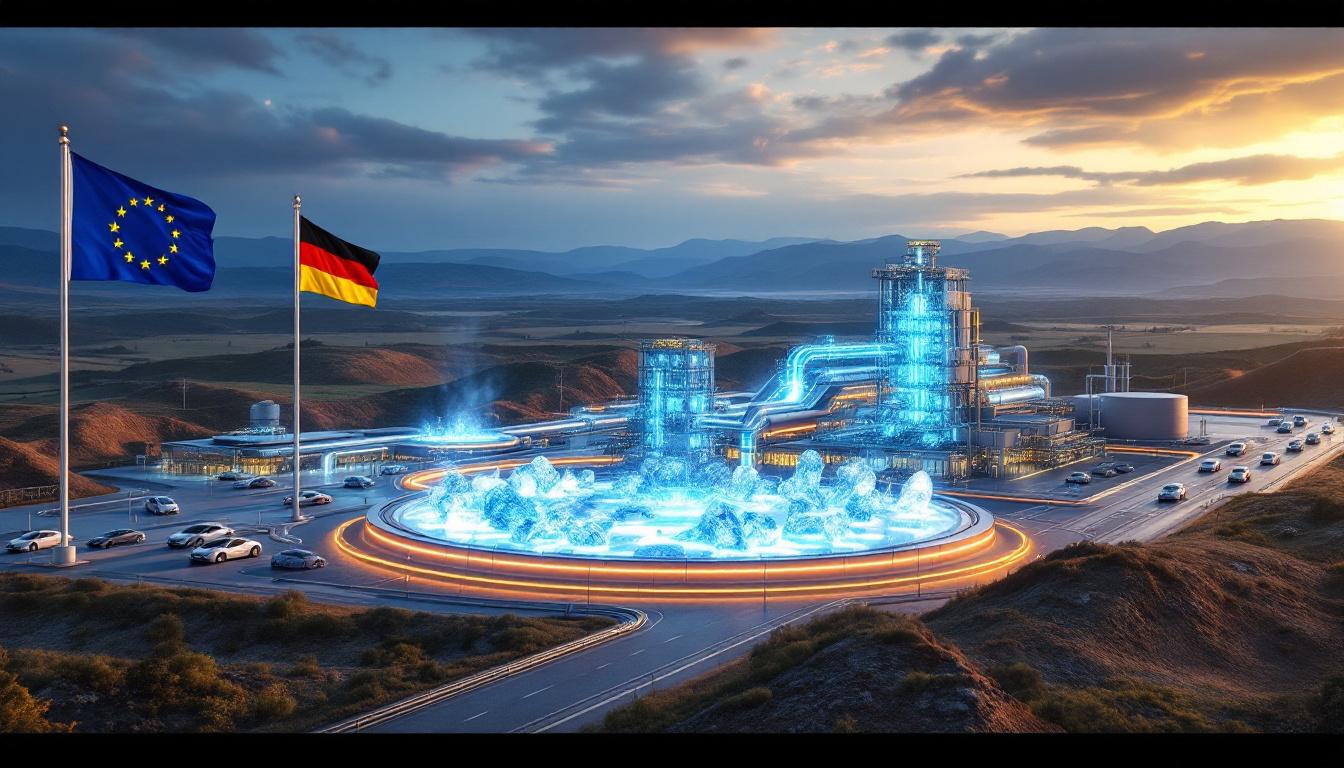How is the U.S. Reshaping Its Critical Minerals Strategy?
Domestic Production Milestones in Rare Earth Elements
A significant breakthrough occurred at Energy Fuels' White Mesa Mill in Utah, which began pilot-scale production of heavy rare earth oxides—specifically dysprosium—marking the first U.S. facility to produce separated heavy REE oxides from mined ore rather than recycled materials. The company plans to expand to terbium and samarium oxides by late 2025, with commercial-scale production targeted for 2026.
This development addresses a crucial gap in the U.S. supply chain for high-performance magnets used in electric vehicles, wind turbines, and defense systems. Energy Fuels' newly acquired Donald mineral sands project in Australia could further strengthen this capacity by 2027, potentially making the company America's only commercial supplier of heavy REE oxides from mined ore.
Private Sector Investments Accelerating the Transition
Apple's $500 million commitment to source rare earth magnets from MP Materials represents a watershed moment for domestic production. Under this arrangement, MP's Fort Worth, Texas facility will supply Apple with domestically manufactured neodymium magnets for products like iPhones and Macs.
The partnership includes developing an advanced recycling line at MP's Mountain Pass, California site to reclaim rare earth elements from end-of-life electronics and reprocess them into new magnets. This creates a closed-loop system—mining to magnets to recycling—entirely within U.S. borders, establishing a model for vertically integrated supply chain resilience.
Pentagon's Price Floor: A Game-Changing Intervention
Perhaps the most revolutionary development is the Department of Defense's unprecedented price guarantee for certain critical rare earth oxides. The Pentagon will guarantee a minimum price of $110 per kilogram for neodymium and praseodymium (NdPr)—roughly double the current market rate set by China—for the next decade.
This price floor fundamentally alters the economics of rare earth production in the U.S. By establishing a lucrative minimum price well above Chinese levels, the government aims to stimulate investment that has long been deterred by China's ability to manipulate prices. MP Materials has already announced plans to expand magnet production to 10,000 tons annually—approximately equal to total U.S. demand—with the Pentagon serving both as price backstop and major shareholder through a $400 million stock investment.
What Financial Innovations Are Emerging in Critical Minerals?
Tokenization: Turning Physical Minerals into Digital Assets
A groundbreaking partnership between CVMR Corporation and Finatrades is pioneering the tokenization of physical critical minerals. This initiative aims to transform illiquid mineral reserves into tradable digital assets by creating tokens backed 1:1 by stockpiles of refined metals—whether nickel ingots, cobalt powder, rare earth oxides, or uranium—securely stored and verified for purity.
By combining CVMR's metallurgical expertise with Finatrades' asset-tokenization technology, the venture could open new liquidity channels for critical minerals and provide alternative funding routes for mining projects, particularly in resource-rich emerging markets. This approach could allow countries to raise capital against mineral deposits without waiting years for mines to reach full production.
The initiative differs from previous attempts to financialize metals via blockchain by bringing both significant physical inventory and regulatory legitimacy through a Swiss-backed trading infrastructure. While digital tokens won't replace physical supply chains, this "digital alchemy" could complement traditional markets by broadening the investor base and smoothing trade flows.
How is China Responding to Western Critical Mineral Initiatives?
Strategic Export Controls on Battery Technology
China has imposed new export restrictions on advanced electric vehicle battery technology, including technical know-how for lithium processing and manufacturing of lithium iron phosphate (LFP) cathodes. Any transfer of these technologies overseas—whether through joint ventures, licensing, or academic collaboration—now requires special government licensing.
These controls mirror Beijing's earlier restrictions on rare earth magnet materials and underscore a broader strategy to protect China's dominant position in EV battery production, where Chinese firms command approximately 67% of the global market. By restricting access to cutting-edge processing techniques, China aims to maintain its competitive edge in battery metals investment.
While Chinese companies like CATL and BYD continue expanding overseas with cell factories in Europe and Asia, the new rules primarily target upstream processes that largely remain on Chinese soil. This move signals China's determination to maintain control over the most valuable links in the clean technology supply chain.
The Rare Earth-AI Chip Trade Negotiation
Behind closed doors, an uneasy trade détente is emerging that links rare earths and high-tech hardware. U.S. Commerce Secretary Howard Lutnick revealed that Nvidia's pending ability to resume selling certain advanced AI chips to China was connected to negotiations over rare earth elements, specifically referencing an agreement to persuade China to restart shipments of rare earth magnets to U.S. manufacturers.
This development marks a significant reversal of an export ban imposed just months earlier that barred cutting-edge AI chips from China on national security grounds. The timing suggests a delicate bargain: Washington easing tech restrictions in exchange for Beijing lifting or pausing its rare earth export curbs that threatened U.S. industry.
A fragile 90-day truce on rare earths was reportedly reached in early July, temporarily reversing China's magnet embargo to give manufacturers a window to stockpile materials. This arrangement highlights the complex interdependence between critical minerals and advanced technology in great-power negotiations.
How Are U.S. Allies Responding to Critical Mineral Challenges?
Japan-EU Coordination on Rare Earth Procurement
Leaders from Japan and the European Union are preparing to announce an unprecedented joint effort to secure rare earth supplies. The initiative will launch a high-level economic dialogue—involving foreign and economy ministers—focusing on coordinated rare earth procurement and supply chain projects.
The partnership includes public-private collaborations to develop alternative sources of rare earth elements outside China. The EU is also considering simplifying regulations to facilitate Japanese investment in European critical mineral projects. This trans-Pacific alignment underscores a shared urgency: if China restricts material exports, Japan and Europe will work together to develop alternative sources.
Both economic powers have already taken individual steps—the EU launched its Critical Raw Materials Act, while Japan has supported rare earth ventures in Southeast Asia and Australia—but closer cooperation could mean pooling funds or jointly backing mining and refining ventures. This mirrors U.S. actions, including the Department of Defense's multibillion-dollar stake in MP Materials to boost domestic rare earth production.
G7 Critical Minerals Action Plan
The G7 nations recently agreed on a Critical Minerals Action Plan, pledging to coordinate investments in mining projects in Africa and Latin America and to pool strategic stockpiles among allies. This multilateral approach aims to reduce collective dependence on single dominant suppliers through shared resources and coordinated diplomacy.
What Legislative Changes Are Accelerating U.S. Critical Minerals Development?
From Tax Credits to Direct Funding
Congress is shifting its approach from tax incentives to direct funding and authority. A provision in the House's latest omnibus bill would repeal a dormant 10% production tax credit for critical minerals (deemed too slow and indirect) and replace it with:
- $2.5 billion for direct purchase of U.S.-mined minerals for the national stockpile
- $500 million in low-interest Defense Department loans
The Senate's draft includes similar provisions plus over $3 billion in grants and a $5 billion investment fund for the industrial base. House Republicans have also introduced legislation explicitly authorizing seabed mining in U.S. waters for the first time, aiming to tap deep ocean mineral resources.
Executive Branch Coordination and Streamlining
A recent presidential memorandum mandated a "single application portal" for companies seeking federal support for critical mineral projects, forcing agencies to share data and reduce bureaucratic obstacles. The Department of Energy has reprogrammed R&D funds toward critical materials and away from certain climate projects, signaling a priority shift toward materials security.
Regulatory changes are also easing the path for mining permits—a Supreme Court ruling in June narrowed environmental reviews under NEPA, so agencies no longer need to consider distant downstream effects of mining operations. This change is expected to shorten litigation and permitting timelines for new projects, following on from Trump's critical minerals order which had similar aims.
How Are Nuclear Energy and Critical Minerals Intersecting?
Advanced Nuclear Fuel Production Initiative
The Department of Energy announced a pilot program to build advanced domestic nuclear fuel production lines, aiming to end reliance on imported enriched uranium for next-generation reactors. The program solicits private companies to construct and operate new fuel fabrication facilities under DOE oversight, with an initial target of selecting at least three advanced reactor designs by late summer.
The aggressive timeline envisions these pilot fuel lines achieving initial operation by July 4, 2026—a date chosen to meet the needs of demonstration reactors slated to come online around that time. This initiative responds to directives to revive the U.S. nuclear energy sector and reduce dependence on Russian-supplied uranium fuel, with significant implications for US uranium production.
AI-Accelerated Nuclear Licensing
Microsoft and the Idaho National Laboratory announced a partnership to use artificial intelligence to speed up the permitting process for new nuclear plants. One of the biggest bottlenecks for nuclear construction is the painstaking assembly of license applications—thousands of pages of engineering analyses, safety models, and environmental reports.
Microsoft's AI tools, trained on decades of prior successful applications, will auto-generate draft sections of these complex documents by pulling data from past studies and regulatory precedents. This initiative aligns with recent executive orders to halve the nuclear licensing timeline (aiming for 18 months instead of many years) to accelerate reactor deployments.
What Unintended Consequences Are Emerging from Resource Nationalism?
Copper Tariff Impact on Manufacturing
A cautionary tale about the unintended impacts of resource politics is unfolding as American automakers nervously eye a potential 50% tariff on imported copper. The tariff announcement sent U.S. copper prices to record highs on the COMEX exchange—over $5.68 per pound, an unprecedented premium of nearly $3,000 per ton above global benchmark prices.
Auto parts manufacturers have begun notifying carmakers they would need to raise prices, unable to absorb the extra duties and raw material cost increases. Analysis suggests that with the copper tariff in place, the tariff-related cost per vehicle would rise to about $1,700 for every car made in the U.S. and as high as $3,500 for each car imported from Mexico or Canada.
This illustrates how policies aimed at bolstering domestic metals production or addressing trade imbalances can have significant downstream effects on manufacturing industries that rely on these materials, which is particularly relevant in the context of energy transition minerals.
What Does This Mean for the Future of Critical Minerals?
The convergence of policy developments across government, industry, and finance signals a fundamental shift in how nations approach critical mineral resources. These materials have moved from specialized industry concerns to central elements of economic statecraft and national security strategy.
Key trends to watch include:
- The effectiveness of price guarantees in stimulating domestic production
- Whether tokenization can successfully create new financing models for mineral projects
- How the uneasy trade détente between technology and minerals evolves
- The impact of allied coordination on diversifying global supply chains
- Whether regulatory streamlining can significantly accelerate new project development
As nations sprint to build more resilient supply chains, they are discovering both new opportunities and friction points. The only certainty is that the week critical minerals broke the policy sound barrier is just the beginning of a new era in resource policy.
Table: Key Critical Mineral Policy Developments in One Week
| Development | Country/Entity | Significance |
|---|---|---|
| Rare earth price floor ($110/kg) | United States | Creates economic viability for domestic production |
| Heavy REE oxide production | United States | First domestic production from mined ore |
| $500M Apple-MP Materials deal | United States | Creates closed-loop domestic magnet supply chain |
| Battery technology export controls | China | Protects dominance in EV supply chain |
| Rare earth-AI chip trade negotiations | US-China | Links technology and minerals in diplomatic bargaining |
| Critical mineral tokenization | Canada/Dubai | Creates new financial instruments for mineral assets |
| Japan-EU procurement partnership | Japan/EU | Coordinates allied efforts to secure alternative supplies |
| Nuclear fuel production initiative | United States | Addresses uranium supply chain vulnerabilities |
| AI-accelerated nuclear licensing | United States | Uses technology to overcome regulatory bottlenecks |
| Potential 50% copper tariff | United States | Demonstrates unintended consequences of resource nationalism |
What Questions Should Investors and Policymakers Be Asking?
For Investors:
- Will government price guarantees create sustainable economics for rare earth production, or merely temporary opportunities?
- How might tokenization of mineral assets change investment strategies in the resource sector?
- Which companies are best positioned to benefit from the acceleration of domestic critical mineral processing?
- What downstream industries might face cost pressures from resource nationalism policies?
For Policymakers:
- How can price support mechanisms be structured to stimulate production without creating market distortions?
- What is the right balance between securing domestic supply and maintaining international trade relationships?
- How can regulatory streamlining be achieved while maintaining appropriate environmental safeguards?
- What role should strategic stockpiles play in critical mineral security strategies?
Further Exploration
Readers interested in learning more about critical minerals policy developments can also explore investment opportunities 2025 and review the latest insights from the Critical Minerals Institute, which provides detailed analysis on how these policy shifts might impact various sectors of the economy.
Want to Know When the Next Major Mineral Discovery Happens?
Stay ahead of the market with Discovery Alert's proprietary Discovery IQ model, which delivers instant notifications of significant ASX mineral discoveries like those transforming companies such as De Grey Mining. Explore why major mineral discoveries can lead to substantial returns by visiting the dedicated discoveries page and position yourself for success with actionable investment insights.




